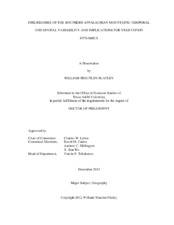| dc.description.abstract | Ecologists continue to debate the role of fire in forests of the southern Appalachian Mountains. How does climate influence fire in these humid, temperate forests? Did fire regimes change during the transition from Native American settlement to Euro-American settlement? Are fire regime changes resulting in broad vegetation changes in the forests of eastern North America? I used several approaches to address these questions.
First, I used digitized fire perimeter maps from Great Smoky Mountains National Park and Shenandoah National Park for 1930-2009 to characterize spatial and temporal patterns of wildfire by aspect, elevation, and landform. Results demonstrate that fuel moisture is a primary control, with fire occurring most frequently during dry years, in dry regions, and at dry topographic positions. Climate also modifies topographic control, with weaker topographic patterns under drier conditions.
Second, I used dendroecological methods to reconstruct historical fire frequency in yellow pine (Pinus, subgenus Diploxylon Koehne) stands at three field sites in the southern Appalachian Mountains. The fire history reconstructions extend from 1700 to
2009, with composite fire return intervals ranging from 2-4 years prior to the fire protection period. The two longest reconstructions record frequent fire during periods of Native American land use. Except for the recent fire protection period, temporal changes in land use did not have a significant impact on fire frequency and there was little discernible influence of climate on past fire occurrence.
Third, I sampled vegetation composition in four different stand types along a topographic moisture gradient, including mesic cove, sub-mesic white pine (Pinus strobus L.) hardwood, sub-xeric oak (Quercus L.), and xeric pine forests in an unlogged watershed with a reconstructed fire history. Stand age structures demonstrate changes in establishment following fire exclusion in xeric pine stands, sub-xeric oak stands, and sub-mesic white pine-hardwood stands. Fire-tolerant yellow pines and oaks are being replaced by shade-tolerant, fire sensitive species such as red maple (Acer rubrum L.) and hemlock (Tsuga canadensis L. Carr.). Classification analysis and ordination of species composition in different age classes suggest a trend of successional convergence in the absence of fire with a shift from four to two forest communities. | en |


